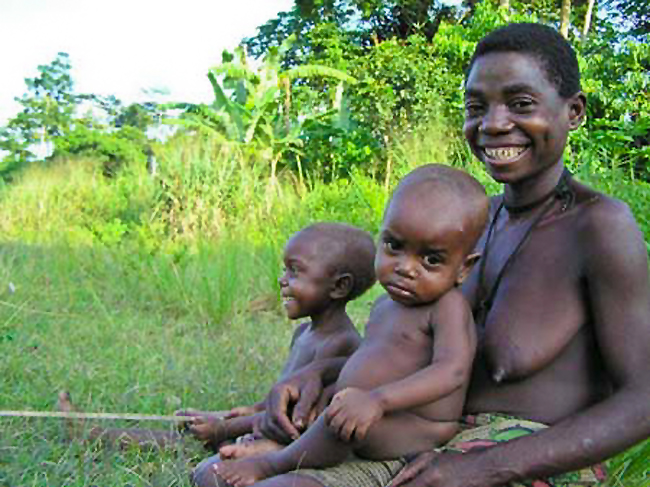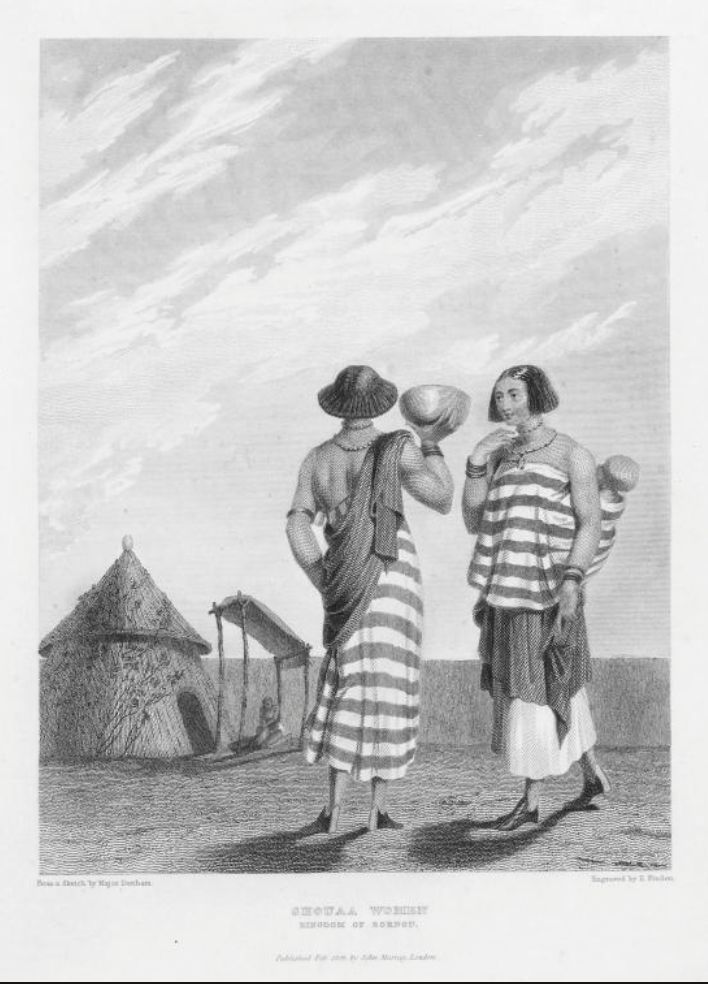|
Ethnic Groups In The Central African Republic
Demographic features of the population of the Central African Republic include population density, ethnicity, education level, health of the populace, economic status, religious affiliations and other aspects of the population. There are more than 80 ethnic groups in the Central African Republic (CAR), each with its own language. The largest ethnic groups are Gbaya (Baya) 28.8%, Banda 22.9%, Mandjia 9.9%, Sara 7.9%, M'Baka-Bantu 7.9%, Arab-Fulani (Peuhl) 6%, Mbum 6%, Ngbanki 5.5%, Zande-Nzakara 3%, other Central African Republic ethnic groups 2%, non-Central African Republic ethnic groups .1%, as of 2003. Sangho, the language of a small group along the Oubangui River, is the national language spoken by the majority of Central Africans. Only a small part of the population has more than an elemental knowledge of French, the official language. More than 55% of the population of the CAR lives in rural areas. The chief agricultural areas are around the Bossangoa and Bambari ... [...More Info...] [...Related Items...] OR: [Wikipedia] [Google] [Baidu] |
Azande People
The Azande are an ethnicity, ethnic group in Central Africa speaking the Zande languages (whose classification is uncertain). They live in south-eastern Central African Republic, north-eastern Democratic Republic of the Congo, as well as south-central and south-western South Sudan. The Congolese Azande live in Orientale Province along the Uele River; Isiro, Dungu, Democratic Republic of the Congo, Dungu, Kisangani and Duruma. The Central African Azande live in the districts of Rafaï, Zemio, Bangasu and Obo. The Azande of South Sudan live in Central Equatoria, Central, Western Equatoria and Western Bahr al-Ghazal States, Yei, Maridi, Yambio, Tombura, Deim Zubeir, Wau Town and Momoi. History The Azande were formed by a military conquest during the first half of the 18th century. They were led by two Dynasty, dynasties that differed in origin and political strategy. The Vungara clan created most of the political, linguistic, and cultural parts. A non-Zande dynasty, the Bandia, ... [...More Info...] [...Related Items...] OR: [Wikipedia] [Google] [Baidu] |
Kara People
The Kara are an ethnic group inhabiting South Sudan and the Central African Republic. They speak the Gula language, and Nilo-Saharan, which is a Central Sudanic language. The Kara religion is an animist faith. As a population, they exceed 100,000 members. They mainly live in South Sudan's Western Bahr el Ghazal Western Bahr el Ghazal is a state in South Sudan. It has an area of and as of 2020 has estimated 600,000 in population. It is part of the Bahr el Ghazal region. Its capital is Wau. The state shared international borders with Sudan to the north ... state. Daily life The Kara are a semi-nomadic people. They live in round huts made up of a framework of tree branches plastered with mud and the conical roof thatched with local grasses. A typical Kara village has 20 to 30 huts around a meeting place and also enclosures of branches to keep cattle and goats. The Kara tribe grow Sorghum, corn, beans, pumpkins and peanuts. The staples are Sorghum, made into a porridge either w ... [...More Info...] [...Related Items...] OR: [Wikipedia] [Google] [Baidu] |
Aka People
The Aka or Biaka (also ''Bayaka, ''Babenzele) are a nomadic African Pygmies, Mbenga pygmy people. They live in south-western Central African Republic and in northern Republic of the Congo. They are related to the Baka (Cameroon and Gabon), Baka people of Cameroon, Gabon, northern Congo, and southwestern Central African Republic. Unlike the Mbuti pygmies of the eastern Congo (who speak only the language of the tribes with whom they are affiliated), the Aka speak Aka language, their own language along with whichever of the approximately 15 Bantu peoples they are affiliated. In 2003, the oral traditions of the Aka were proclaimed one of the Masterpieces of the Oral and Intangible Heritage of Humanity by UNESCO. They were featured in the July 1995 National Geographic Magazine, National Geographic article "Ndoki: the Last Place on Earth", and a 3-part TV series. Society A traditional hunter-gatherer society, the Aka have a varied diet that includes 63 plants, 28 species of game ... [...More Info...] [...Related Items...] OR: [Wikipedia] [Google] [Baidu] |
Baka People (Cameroon And Gabon)
The Baka people, known in the Congo as Bayaka (''Bebayaka, Bebayaga, Bibaya''), are an ethnic group inhabiting the southeastern rain forests of Cameroon, northern Republic of the Congo, northern Gabon, and southwestern Central African Republic. They are sometimes called a subgroup of the Twa, but the two peoples are not closely related. Likewise, the name "Baka" is sometimes mistakenly applied to other peoples of the area who, like the Baka and Twa, have been historically called pygmies, a term that is now considered derogatory. Identity Baka people are all hunter-gatherers, formerly referred to as pygmies, located in the Central African rain forest. Having average heights of 1.52 meters (5 feet) as well as living semi-nomadic lifestyles, the Baka are often discriminated against and marginalized from society. They reside in southeastern Cameroon, northern Gabon and in the northern part of the Republic of Congo. In Congo, the Baka people are otherwise known as the Bayaka. Some ... [...More Info...] [...Related Items...] OR: [Wikipedia] [Google] [Baidu] |
Baggara
The Baggāra ( "heifer herder"), also known as Chadian Arabs, are a nomadic confederation of people of mixed Arab and Arabized indigenous African ancestry, inhabiting a portion of the Sahel mainly between Lake Chad and the Nile river near south Kordofan, numbering over six million. They are known as Baggara and Abbala in Sudan, and as Shuwa Arabs in Cameroon, Nigeria and Western Chad. The term Shuwa is said to be of Kanuri origin. The Baggāra mostly speak their distinct dialect, known as Chadian Arabic. However the Baggāra of Southern Kordofan, due to contact with the sedentary population and the Sudanese Arab camel herders of Kordofan, has led to some Sudanese Arabic influence on the dialect of that zone. They also have a common traditional mode of subsistence, nomadic cattle herding, although nowadays many lead a settled existence. Nevertheless, collectively they do not all necessarily consider themselves one people, i.e., a single ethnic group. The term "baggara culture" ... [...More Info...] [...Related Items...] OR: [Wikipedia] [Google] [Baidu] |
Central African Republic Population 1950-2021 UN World Population Prospects 2022
Central is an adjective usually referring to being in the center of some place or (mathematical) object. Central may also refer to: Directions and generalised locations * Central Africa, a region in the centre of Africa continent, also known as Middle Africa * Central America, a region in the centre of America continent * Central Asia, a region in the centre of Eurasian continent * Central Australia, a region of the Australian continent * Central Belt, an area in the centre of Scotland * Central Europe, a region of the European continent * Central London, the centre of London * Central Region (other) * Central United States, a region of the United States of America Specific locations Countries * Central African Republic, a country in Africa States and provinces * Blue Nile (state) or Central, a state in Sudan * Central Department, Paraguay * Central Province (Kenya) * Central Province (Papua New Guinea) * Central Province (Solomon Islands) * Central Province, Sri Lanka ... [...More Info...] [...Related Items...] OR: [Wikipedia] [Google] [Baidu] |
UN DESA
The United Nations Department of Economic and Social Affairs (UN DESA) is part of the United Nations Secretariat and is responsible for the follow-up to major United Nations Summits and Conferences, as well as services to the United Nations Economic and Social Council and the Second and Third Committees of the United Nations General Assembly. UN DESA assists countries around the world in agenda-setting and decision-making with the goal of meeting their economic, social and environmental challenges. It supports international cooperation to promote sustainable development for all, having as a foundation the 2030 Agenda for Sustainable Development and the 17 Sustainable Development Goals (SDGs) as adopted by the UN General Assembly on 25 September 2015. In providing a broad range of analytical products, policy advice, and technical assistance, UN DESA effectively translates global commitments in the economic, social and environmental spheres into national policies and actions and co ... [...More Info...] [...Related Items...] OR: [Wikipedia] [Google] [Baidu] |
Bangassou
Bangassou is a city in the southeastern of Central African Republic, lying on the north bank of the Mbomou River. It has a population of 24,447 (2003 census) and is the capital of the Mbomou prefecture. It is known for its wildlife, market, and nearby Bangassou Airport and is linked by ferry to the Democratic Republic of Congo on the south bank. The city is also home to the Roman Catholic Diocese of Bangassou. Axmin Mining Camp and Kembé Falls are located in the area. History During the French colonial occupation of Congo Free State, the French military established a base at Bangassou. In 1922 the Spiritains established a Catholic mission in the town. In 1931 the société cotonnière Comouna built a cotton processing plant in the town. In 1935 the town became the capital of the Department of Mbomou. Together with Sibut, Bangassou received electricity in 1980. Sultanate Bangassou has been a Sultanate since at least the early 18th century. It was founded by the Bamba ... [...More Info...] [...Related Items...] OR: [Wikipedia] [Google] [Baidu] |
Bangui
Bangui (; or Bangî in Sango language, Sango, formerly written Bangi in English) is the Capital (political), capital and List of cities in the Central African Republic, largest city of the Central African Republic. It was established as a French Congo, French outpost in 1889 and named after its location on the northern bank of the Ubangi River (); the Ubangi itself was named from the Bobangi language, Bobangi word for the "rapids" located beside the settlement, which marked the end of navigable water north from Brazzaville. The majority of the population of the Central African Republic lives in the western parts of the country, in Bangui and the surrounding area. The city has been part of Bangui (Prefecture), Bangui Prefecture since December 2020. it had an estimated population of 889,231. The city consists of eight urban districts (''arrondissements''), 16 groups (''groupements'') and 205 neighbourhoods (''quartiers''). As the capital of the Central African Republic, Bangui ... [...More Info...] [...Related Items...] OR: [Wikipedia] [Google] [Baidu] |
Bambari
Bambari is a town in the Central African Republic, lying on the Ouaka River. It has a population of 41,356 (2003 census) and is the capital of Ouaka prefecture. Bambari is an important market town and home to Bambari Airport, and the Roman Catholic Diocese of Bambari. History Bambari was electrified in 1970. On 23 December 2012 Bambari was captured by rebels from Séléka coalition. On 24 June 2014 100 Anti-balaka fighters attacked Bambari. 46 people were killed and 28 wounded. In 2015 it was reported that Bambari was split with Anti-balaka controlling the part west of Oukana river and ex-Seleka controlling the eastern part of the city. On 22 February 2017 Ali Darassa and most rebels from Union for Peace in the Central African Republic withdrew from Bambari. Anti-balaka leader followed shortly after. On 10 January 2019 UPC rebels attacked Bambari. The attack was repelled after seven days of battle by government and international forces. More than 40 rebels were kil ... [...More Info...] [...Related Items...] OR: [Wikipedia] [Google] [Baidu] |





